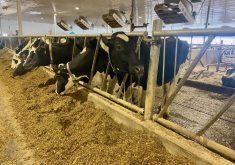CRAIK, Sask. – As the building beside Highway 11 moved from paper to wood, the doubters became convinced that the Town and Rural Municipality of Craik were onto something after all.
A 6,000 sq. metre building, built with the environment in mind, opened July 3 east of the town of 450 in central Saskatchewan. Located on 127 acres donated by the RM, the building has a restaurant and will serve as headquarters for the golf club and as a proposed meeting place for businesses and government staff, halfway between Regina and Saskatoon.
Read Also

Farmland ownership fires up Saskatchewan politicians
Saskatchewan politicians debate the enforcement of farmland ownership laws in the province.
Glenn Hymers, a retired teacher who was convinced early on that the vision was a valid one, became chair of Craik’s EcoAction Committee.
“For a small community it’s a huge investment of money, time, volunteers,” he said.
“In every community there are naysayers. Now that the building is here, many more have bought in.”
The $1 million building received little government funding, relying instead on donations of supplies, services and labour.
The biggest grant was $100,000 from the Federation of Canadian Municipalities, acquired through the efforts of the RM and town councils and secretaries. Smaller amounts came from the TD Bank and Sask Water, as well as individuals.
While many small Saskatchewan communities are looking for ways to revitalize themselves, Craik’s residents have gambled on the increasing public recognition of environmental issues.
“They could have put up a spa,” said project co-ordinator Mary Beckie, but the community chose a different way to develop itself.
“This building is built as a demonstration – waste, solar heat, straw bale walls – I don’t pretend to understand technicalities,” Hymers said over coffee in the eco-centre restaurant.
“My jaw drops when people talk about water filtration.”
Curious passersby from the 5,000 vehicles that drive the highway daily would come in for impromptu tours with the construction staff once the framework bales and beams went up.
“That’s when people started lurching to a stop on the highway,” Hymers said.
Eventually the committee had to hire people to give official tours at 10 a.m. and 2 p.m. to avoid compromising public safety and the project’s deadline.
The building is a dream child of retired University of Saskatchewan professor Lynn Oliphant. He spoke to several communities about doing a green demonstration, and Beckie said “the idea struck a chord with people” during a meeting in Craik in 2001.
The heart of the building’s energy savings starts with a heat pump and 1,440 metres of pipe buried three m into the ground to collect heat from the earth.
The building copes with winter cold by having areas that collect and hold the sun’s heat, such as a long wall built of stones from local farm fields, a European-style brick oven that also bakes the restaurant’s bread, large double-glazed windows on the south side to let in the sun and smaller, triple-glazed windows with shutters on the north side.
The plans are to cope with summer heat by using the heat pump to bring in the cooler ground temperature through water in pipes. There is no air conditioning system; fans move air in the high-ceilinged building. An overhang for the front windows blocks the summer sun, which is higher in the sky than in winter.
The walls are compressed straw bales, covered in stucco, which have an insulation value of R40. The post-and-beam construction allows a light airy look inside and there are no metal connectors for the posts, which were fastened in place from recycled beams from the local torn-down Cargill grain elevator.
Liquid and solids from the composting toilets are separated and will eventually be spread on the nearby golf course.
Although the building sits on the edge of the Arm River Valley and overlooks the town’s reservoir, it does not use town water. Snow and water that run off the metal roof are stored in a cistern and treated with a variety of filters and osmosis.
Wood, green plants and stone are common elements in the building, as befits its ecological theme.
“The building here is a symbol of the project, but it is only one part,” Hymers said.
The next stages involve educating others about green initiatives, said Beckie, who was hired in October 2003 to help carry out the plan. A resource library offers information on climate change and a course is being developed for students in the Davidson School Division. Last winter the project held eight seminars dealing with various ecological and agricultural topics. The intent is to continue the seminars this year.
The community is also applying for grants to look at sustainable land and energy use, building construction and waste management.
A housing subdivision near the centre is also planned, where people committed to a green lifestyle could live and work.
Potential spinoffs include the recent announcement by a Vancouver company called Hemptown that plans to gather hemp straw from local farmers, mill it in Craik and sell hemp clothing from the eco-centre.
Traditional tourism is also getting a boost as birders and the nearby Craik Regional Park draw people off Highway 11, also known as the Louis Riel Trail.
The work continues, Hymers said.
“Some days we have two or three meetings – steering, parking, funding. I’m really enjoying it. Now I come out and help with painting or swinging a hammer.”
Hymers said dozens of people are involved in the project. Fundraising is still a big part, including a buy-a-bale campaign, and the committee would love to get a wind turbine on site.














